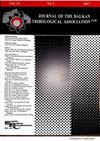FRICTION AND WEAR BEHAVIOUR OF INTERMETALLIC Ni60Ti40 ALLOY MODIFIED WITH ALUMINIUM
Q3 Engineering
引用次数: 0
Abstract
Tribological properties of nickel titanium-based alloys were investigated systematically. One binary (Ni60Ti40) and two ternary (Ni58.8Ti39.2Al2, Ni57Ti38Al5) alloys were fabricated using a conventional sintering process. Their friction and wear properties were studied using a reciprocating dry sliding method against 440C steel at temperatures up to 200 degrees C. The results showed that the addition of aluminium reduced the friction coefficient of Ni60Ti40 alloy and increased its wear resistance at all test temperatures. The results obtained were related to microstructure of the alloys and their wear mechanisms. Wear surface of the alloys were characterised mainly by smearing indicating that adhesion was the dominant mechanism governing the friction and wear behaviour of the alloys. At elevated temperature, the area of smearing layer became more visible.铝改性Ni60Ti40金属间合金的摩擦磨损性能
系统地研究了镍钛基合金的摩擦学性能。采用常规烧结工艺制备了一种二元合金(Ni60Ti40)和两种三元合金(Ni58.8Ti39.2Al2, Ni57Ti38Al5)。采用往复干滑动法研究了Ni60Ti40合金与440C钢在高达200℃温度下的摩擦磨损性能。结果表明,铝的加入降低了Ni60Ti40合金的摩擦系数,提高了Ni60Ti40合金在所有温度下的耐磨性。所得结果与合金的显微组织及其磨损机理有关。合金的磨损表面主要以粘着为特征,表明粘着是控制合金摩擦磨损行为的主要机制。温度升高时,涂抹层的面积更加明显。
本文章由计算机程序翻译,如有差异,请以英文原文为准。
求助全文
约1分钟内获得全文
求助全文
来源期刊
CiteScore
1.10
自引率
0.00%
发文量
4
审稿时长
3.0 months
期刊介绍:
The decision for editing and printing of the current journal was taken on Balkantrib''93, Sofia, October, 1993 during the Round Table discussion of the representatives of the Balkan countries: Bulgaria. Greece, Former Yugoslavian Republic of Macedonia, Romania, Turkey and Yugoslavia. The Journal of the Balkan Tribological Assosiation is dedicated to the fundamental and technological research of the third principle in nature - the contacts. The journal will act as international focus for contacts between the specialists working in fundamental and practical areas of tribology. The main topics and examples of the scientific areas of interest to the Journal are:
overall tribology;
tribotechnics and tribomechanics; friction, lubrication, abrasive wear, boundary lubrication, adhesion, cavitation, corrosion, computer simulation, vibration phenomena, mechanical contacts in gaseous, liquid and solid phase, technological tribological processes, coatings, etc.;
tribochemistry - defects in solid bodies, tribochemical emissions, triboluminescence, tribochemiluminescence, technological tribochemistry; composite materials, polymeric materials in mechanics and tribology; special materials in military and space technologies, etc.;
kinetics, thermodynamics and mechanism of tribochemical processes;
biotribology - biological tribology, tribophysiotherapy, tribological wear, biological tribotechnology, etc.;
lubrication - solid, semi-liquid lubricants, additives for oils and lubricants, surface phenomena. wear in the presence of lubricants; lubricity of fuels;
ecological tribology; the role of tribology in the sustainable development of technology:
management and organisation of the production; machinery breakdown; oil monitoring;
European legislation in the field of tribotechnics and lubricating oils;
educational problems in tribology, lubricating oils and fuels.

 求助内容:
求助内容: 应助结果提醒方式:
应助结果提醒方式:


